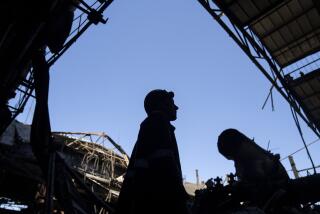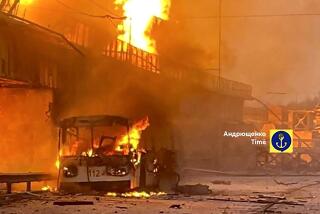Soviets Pressed for Speed and Harvested Chernobyl
It is clear now that the accident at the Chernobyl atomic energy station in the Ukraine is of catastrophic proportions. In the past, Soviet authorities have refused to acknowledge even the possibility of an accident. As recently as February, Radio Kiev was extoling the safety mechanisms at Chernobyl, commenting that the surrounding area was so pollution-free that the plantâs reservoir was even being used for fish breeding.
The plant, located about 80 miles north of Kiev--a city of more than 2 million--is one of nine nuclear power facilities either in operation or under construction in the Ukraine, the center of nuclear energy in the western part of the Soviet Union. Commissioned in 1971, the Chernobyl plant was the largest in the Ukraine and one of the four largest in the Soviet Union. And therein lies one problem. Since the construction of nuclear plants in the Soviet Union has traditionally been behind schedule, workers were pushed to hurry construction.
Two more reactors were scheduled to go on-line at Chernobyl between 1986 and 1990. The first was due to begin operation this year--about a year ahead of the already hurried two-year goal that had been set by Soviet authorities. According to one Ukrainian newspaper, Chernobyl was âleading the fieldâ in a race to become the countryâs largest nuclear plant.
The race to complete reactors was part of the new Soviet plan to double the production of nuclear-generated electricity by 1990. In the Ukraine, the plan was for nuclear energy to account for 60% of electricity by the end of the century (it is currently around 12%).
But there is strong evidence that the industryâs growth was so hurried that there was not sufficient time to develop the necessary infrastructure. The Soviets have even admitted that there was a gross shortage of trained technical personnel. A faculty of nuclear energy--the first in the Soviet Union--was created at the Odessa Polytechnical Institute only in 1975; a second scientific institute opened at Kiev last year.
It also was a common practice to employ the services of students to help construct plants during summer vacations. According to a Ukrainian newspaper for communist youth, âbands of studentsâ worked at the Odessa, Rovno, Chernobyl, South, Ukraine and Zaporozhye nuclear power plants in 1985. During the same year, youth brigades at Chernobyl were reported to be working at 150% of the normal work rates.
In February, 1986, Radio Moscow criticized workers at the Odessa plant for failing to keep pace with scheduled plans. On the following day, Radio Kiev followed suit, this time declaring that the construction of the nuclear plant at Rovno, in western Ukraine, was taking place âin an unstable fashion.â
Meanwhile, workersâ needs were ignored. Late last year, Ukrainian party chief Vladimir Shcherbitsky visited the plant at Zaporozhye, and noted that not only was it short of equipment and failing to recruit the necessary personnel, but also that the local authorities had not improved public transportation, or medical and commercial services for the workers, and there were no recreational facilities.
In light of the present disaster, which involves the possible meltdown of two uranium graphite reactors and the strong probability of heavy fatalities, both directly and in the long term as a result of radiation exposure, the big question is why the Soviets rushed into production in an industry of such enormous potential risk.
There are a couple of obvious explanations. The Soviet Union is facing an energy crisis. The reserves that can be easily mined at their biggest coal field in the eastern Ukraine are nearly depleted. The development of new strip mines in Siberia are behind schedule and it is enormously expensive to transport coal from that remote area. Current problems in the oil industry have forced Mikhail S. Gorbachev to rely increasingly on nuclear energy as the most reliable Soviet power source.
The Ukraineâs location on the Soviet western border renders it an ideal spot for plants exporting electricity to Eastern European countries. The new Ukrainian plants are part of a concerted plan to develop nuclear-generated electricity for those neighbors. The plant being constructed at Khmelnitsky in the western Ukraine, for example, is to service Poland and Czechoslovakia; the South plant is being funded jointly with Romania, and will serve both that country and Bulgaria. The bulk of nuclear-generated electricity fed to Hungary undoubtedly comes from the Chernobyl plant; a 750-kilovolt line goes from there directly into Hungary. The Soviets now are paying the penalty for placing economic needs above safety. Despite their self-acclaimed safety record, a smaller accident was reported at the Rovno plant in 1981, but apparently it did little to spur the Soviets to truly improve nuclear industry standards.
Two more plants are under construction at Odessa and Kharkov that appear to be dangerously close to major population centers. And the size of the catastrophe at Chernobyl suggests that the cities of Kiev and Chernigov may be endangered, despite their relative distance from the scene.
Thus the disaster at Chernobyl has not only endangered human life; it also has imperiled the future of the Soviet Unionâs nuclear industry.
More to Read
Sign up for Essential California
The most important California stories and recommendations in your inbox every morning.
You may occasionally receive promotional content from the Los Angeles Times.










